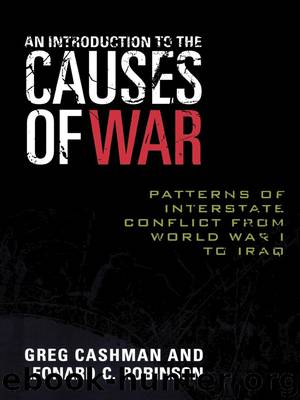An Introduction to the Causes of War by Greg Cashman

Author:Greg Cashman
Language: eng
Format: epub
ISBN: 9781461636540
Publisher: Rowman & Littlefield Publishers
Published: 2013-06-24T16:00:00+00:00
ROOTS OF WAR: LONG-TERM CAUSES
Religion
The conflict between India and Pakistan is often presented as a conflict between Hindus and Muslims, one that links religious rivalry with territorial identity. As Mitra notes, the “standard view tracks the hostile relations down to the unresolved issue of Kashmir, the unfinished agenda of the Partition of British India on religious lines and the growth of Hindu and Islamic fundamentalism in South Asia” (Mitra 2001, 361). Renowned scholar Samuel Huntington sees the ongoing conflict between India and Pakistan as providing empirical evidence for his hypothesis that the international system will be characterized increasingly by a so-called clash of civilizations between seven or eight great cultural blocs within the system. Conflict between these civilizations is particularly likely, says Huntington, in areas where they come into contact and overlap with each other, as is the case with Muslim Pakistan and Hindu India in South Asia. Moreover, a kin-country syndrome purportedly exists in which states are particularly likely to provide material support, and perhaps even to undertake direct military intervention, in defense of their cultural brethren elsewhere. In an interview published in 1998 after India and Pakistan had both successfully tested nuclear weapons, Huntington bluntly states, “The nuclear status certainly confirms the thesis that the clash between civilizations—in this case Islam and Hinduism—has replaced the ideological confrontation of the Cold War as the main characteristic of conflict in today’s world. Obviously India and Pakistan represent different civilizations. They have had 3 wars in the last 50 years” (Huntington 1998).
Stoessinger argues that the core trigger for the twentieth-century wars between India and Pakistan was the history of religious friction between the faiths in South Asia. “The fact that the two hostile religions were represented by sovereign states made the conflict even more ferocious,” he observes. “Nationalism and religion were now fatefully fused with the modern nation-state serving as a handmaiden to religious warfare” (Stoessinger 2001, 112). “Had it not been for long-standing and bitter enmity between Hindus and Muslims,” concludes Stoessinger, “a single state, rather than two hostile ones, would have emerged out of the British colony” (Stoessinger 2001, 134).
In order to analyze the utility of religious friction as an explanatory variable, it is important to understand the long history of the interaction between Islam and Hinduism prior to the partition of India in 1947 and to consider the actual degree to which religion served as a source of identity and conflict within and between the Muslim and Hindu communities of preindependence India. What first brought these two “incompatible” religions into contact was the spread of Islam into South Asia. Although Turkish armies began their raids into the Indian subcontinent as early as 1001, it was not until 1206 that the Qutb-ud-din Aibak government organized the Delhi sultanate.
Muslim rule in India continued for over five centuries. During the sixteenth century, the Muslim sultanate of Bengal was integrated into the Mughal empire, which had been established in the northern section of India. The conversion of Bengalis to Islam, followed by
Download
This site does not store any files on its server. We only index and link to content provided by other sites. Please contact the content providers to delete copyright contents if any and email us, we'll remove relevant links or contents immediately.
The Secret History by Donna Tartt(16664)
The Social Justice Warrior Handbook by Lisa De Pasquale(11495)
Thirteen Reasons Why by Jay Asher(7803)
This Is How You Lose Her by Junot Diaz(5800)
Weapons of Math Destruction by Cathy O'Neil(5049)
Zero to One by Peter Thiel(4837)
The Myth of the Strong Leader by Archie Brown(4796)
Promise Me, Dad by Joe Biden(4459)
Beartown by Fredrik Backman(4435)
Stone's Rules by Roger Stone(4423)
How Democracies Die by Steven Levitsky & Daniel Ziblatt(4416)
The Fire Next Time by James Baldwin(4352)
100 Deadly Skills by Clint Emerson(4089)
A Higher Loyalty: Truth, Lies, and Leadership by James Comey(4041)
Rise and Kill First by Ronen Bergman(4025)
The David Icke Guide to the Global Conspiracy (and how to end it) by David Icke(3894)
The Farm by Tom Rob Smith(3878)
Secrecy World by Jake Bernstein(3790)
The Doomsday Machine by Daniel Ellsberg(3740)
